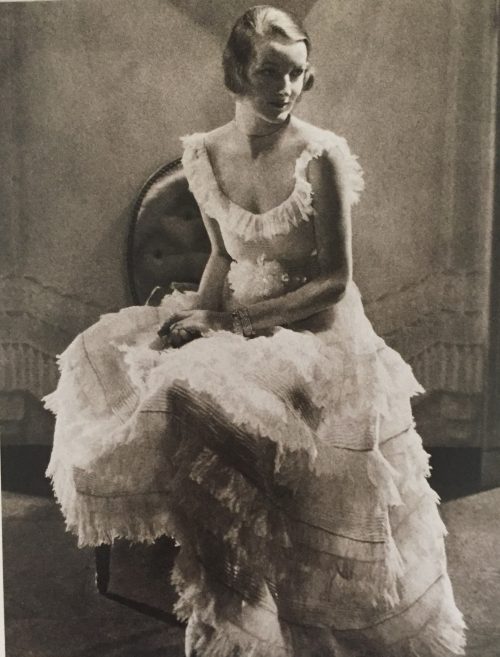
By Cheryl Anderson
“Women think of every colour, except the absence of colours. I have said that black comprises everything. White too. They have an absolute beauty. It is perfect harmony. Dress women in white or black at a ball: they are the only ones you see.”
—Chanel
When Gabrielle Chanel wore white, it’s said, there’s little doubt she wanted to be seen—in other words, noticed. The above quote explains her thoughts regarding la couleur and how impactful it can be. The little black dress from the 1920s did not disappear in the 1930s, but Chanel described the trend for white, “candid innocence and white satin”, during the grey days of the Depression—the stock market had collapsed in October 1929. White had been worn before Chanel’s influence and before the crash, but it was Chanel that made white “in vogue”.
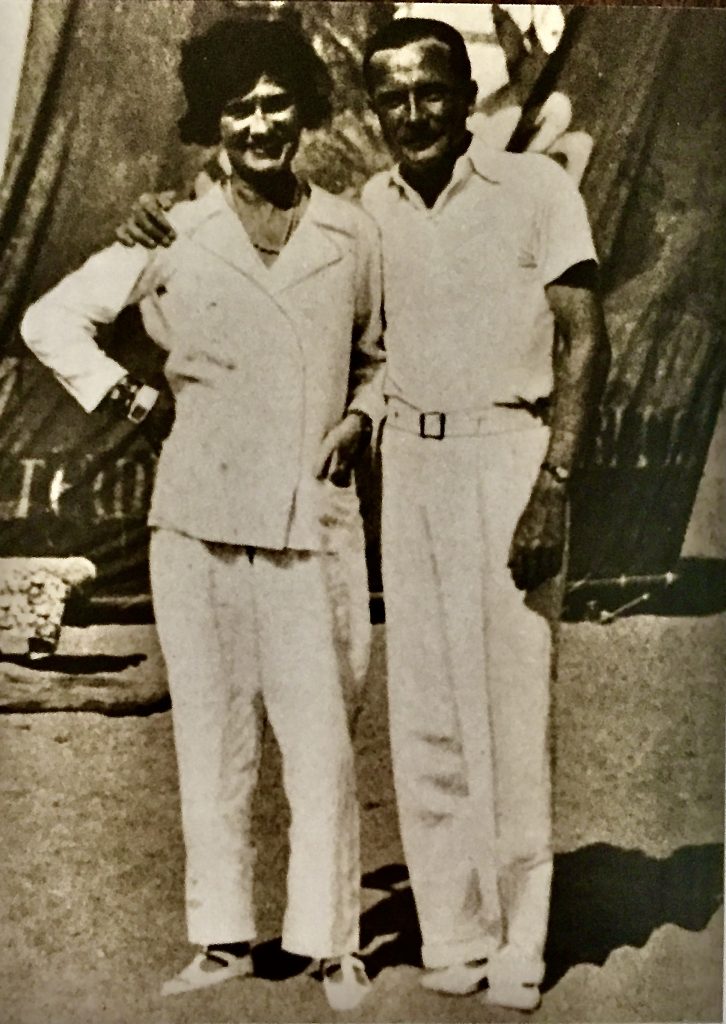
Chanel wearing a white duck jacket and trousers– shown with designer Lucien Lelong. Venice, 1931
Chanel very often appeared in fashion magazines from 1929 going forward, especially in early 1931. In one photo, she’s seen wearing white beach pajamas with jeweled bracelets at the Venice Lido, and in another on her tennis court at La Pausa sporting a white ensemble, white shoes and hat. In 1932, she was photographed aboard Lieutenant Commander Montague Graham White’s steam yacht on Poole Harbour appearing cool and confident in a white dress and jacket.
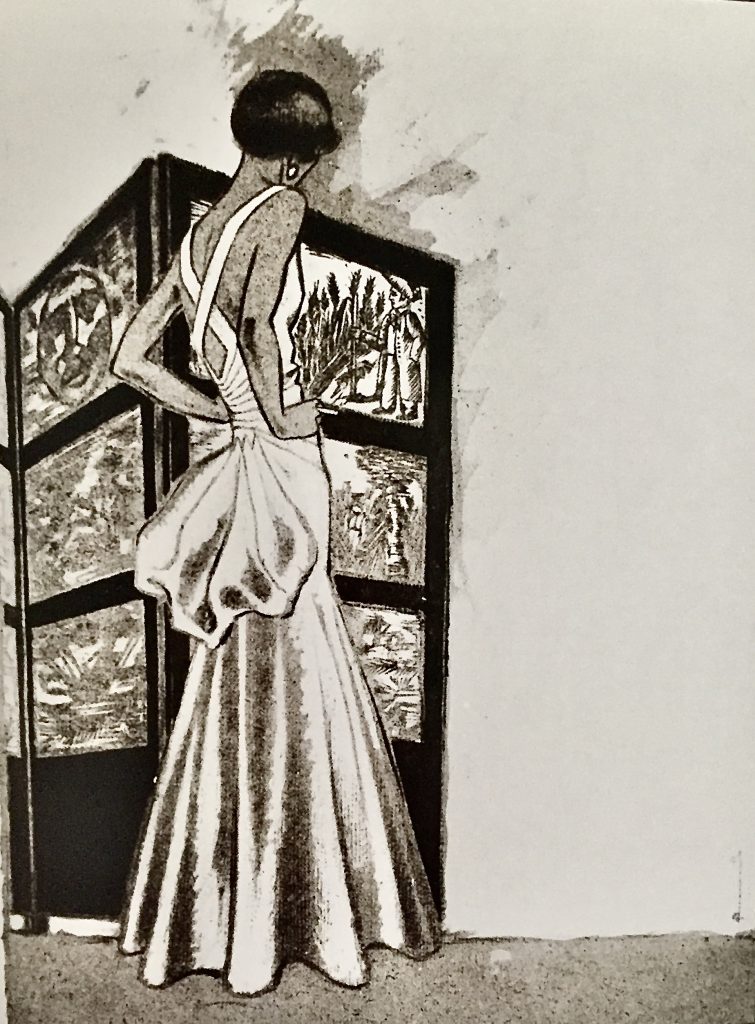
Chanel dress in white satin appearing in Vogue, 1931. A great success in the collection that year. |
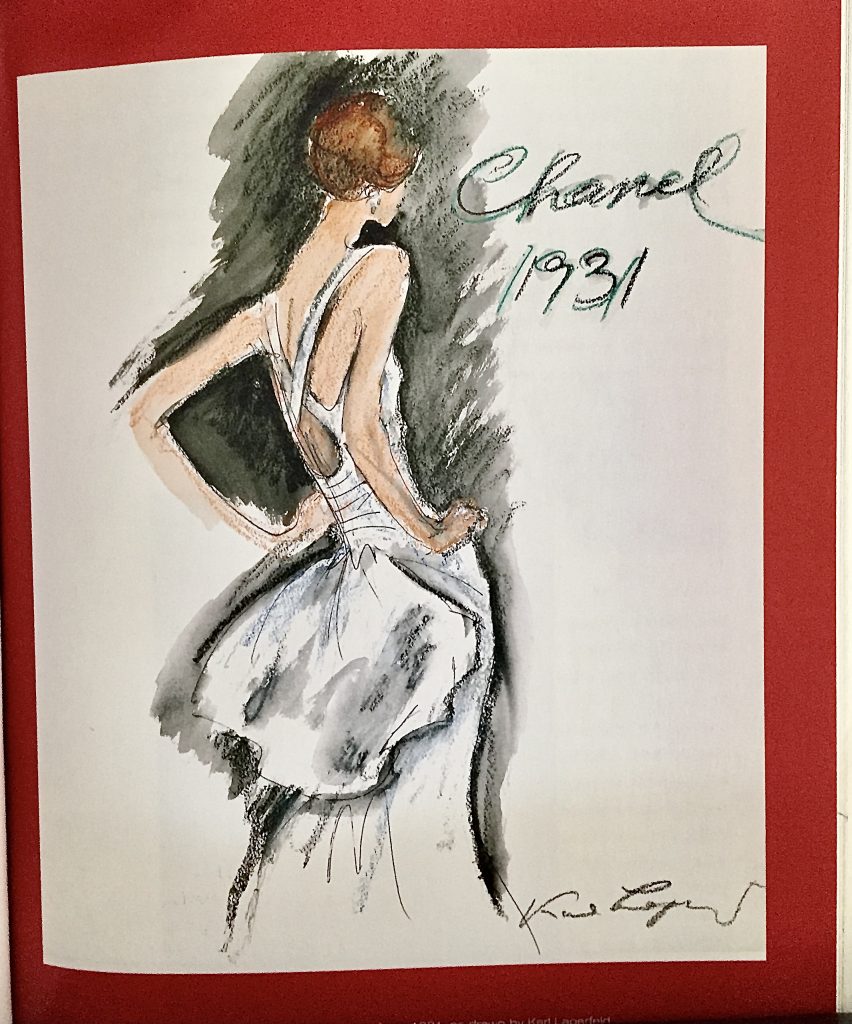
A Chanel-designed white dress in 1931, drawn by Karl Lagerfeld. x |
There are quite a few pictures of Chanel in white satin and pearls at parties and balls in Monte Carlo and Paris. Justine Picardie states: “Janet Flanner, the Paris correspondent for The New Yorker, reporting on the frenetic rounds of June balls in 1930, noted the booming trade that Chanel was doing in the summer after the Wall Street Crash, when Parisian parties were ‘unusually frequent, fantastic, and …remarkable for representing the true spirit of their times’.”
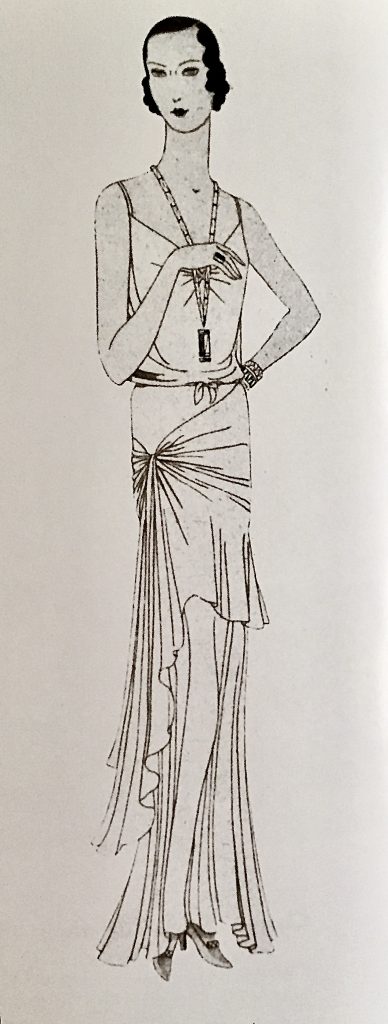
Drawing of a Chanel evening gown appearing in Vogue, February 1930.
One of the most fabulous balls was the White Ball. It was given by the niece of the late Pope Leo XIII. Jean Cocteau created white-plaster masks and wigs. Many of the ladies in attendance wore white gowns designed by Chanel. It was a season that evoked a sparkling, fun driven defiance of the gloom of the crash.
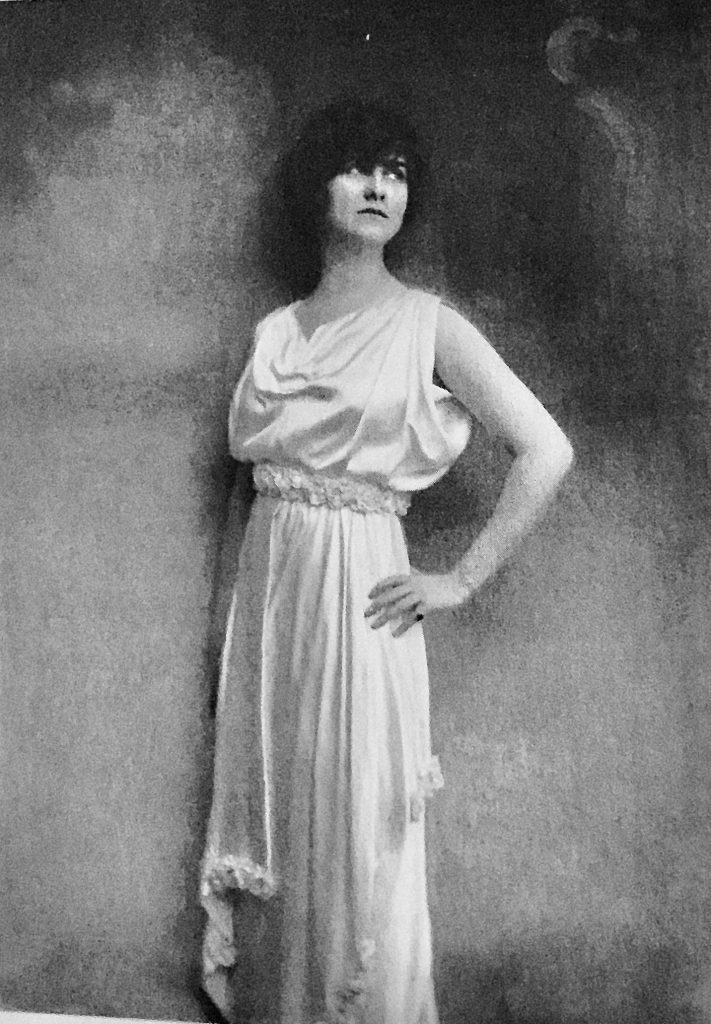
Chanel dressed in white.
Chanel’s all white spring collection in 1933 caught the eye of French Vogue. Picardie relates their impression: “French Vogue was suitably dazzled: ‘A new way of presenting dresses adds to this powerful and palpable springtime feeling that reigns at Rue Cambon. Chanel, for the first time, showing all her white dresses in one setting. It was as if the place had suddenly been transformed into an orchard in Normandy.”
Edmonde Charles-Roux recounts Paul Morand’s interview with Chanel, when she was in Switzerland, quoting her in regards to the origins of white that grabbed the world of the fashionable in 1929. “I was the first to have rugs dyed beige. It reminded me of beaten earth. Right away, furnishings all turned beige, until finally the decorators cried for mercy. Try white satin, I said. Whereupon white swamped their ensembles…” Charles-Roux went on: “Chanel also noted that along with this search for “candid innocence and white satin”came a return to favor of Far Eastern brilliance, bringing white lacquer to walls, Chinese white to vitrines, and white flowers to vases.” It cannot be overstated, satin was “the” festive fabric of the thirties—it spanned every level of society.
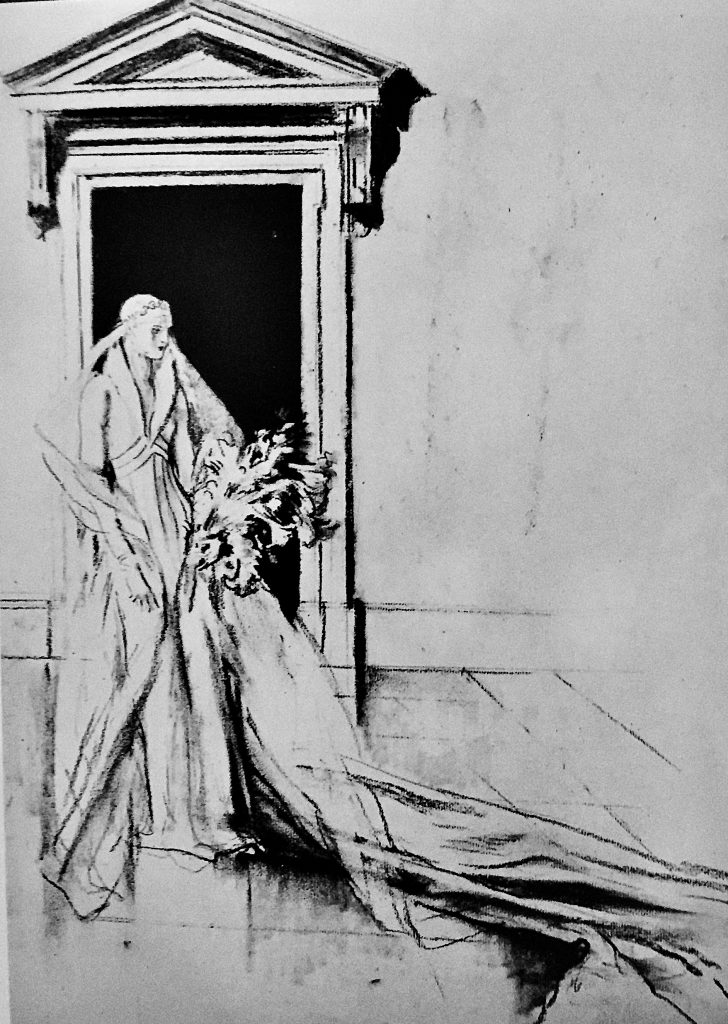
A Chanel wedding dress,1931. It was rare for her to design wedding dresses. Drawn by the gifted illustrator, Drian. |

Another view of the wedding dress drawn by Drian. |
White and beige began appearing in Chanel’s fashions, and in the decor of her villa, La Pausa— living room, dining room and bedroom with curtains in either white taffeta or beige silk in 1929. Roderick Cameron, author of The Golden Riviera, mentioned in his book the no couleur motif when describing his impressions of La Pausa.
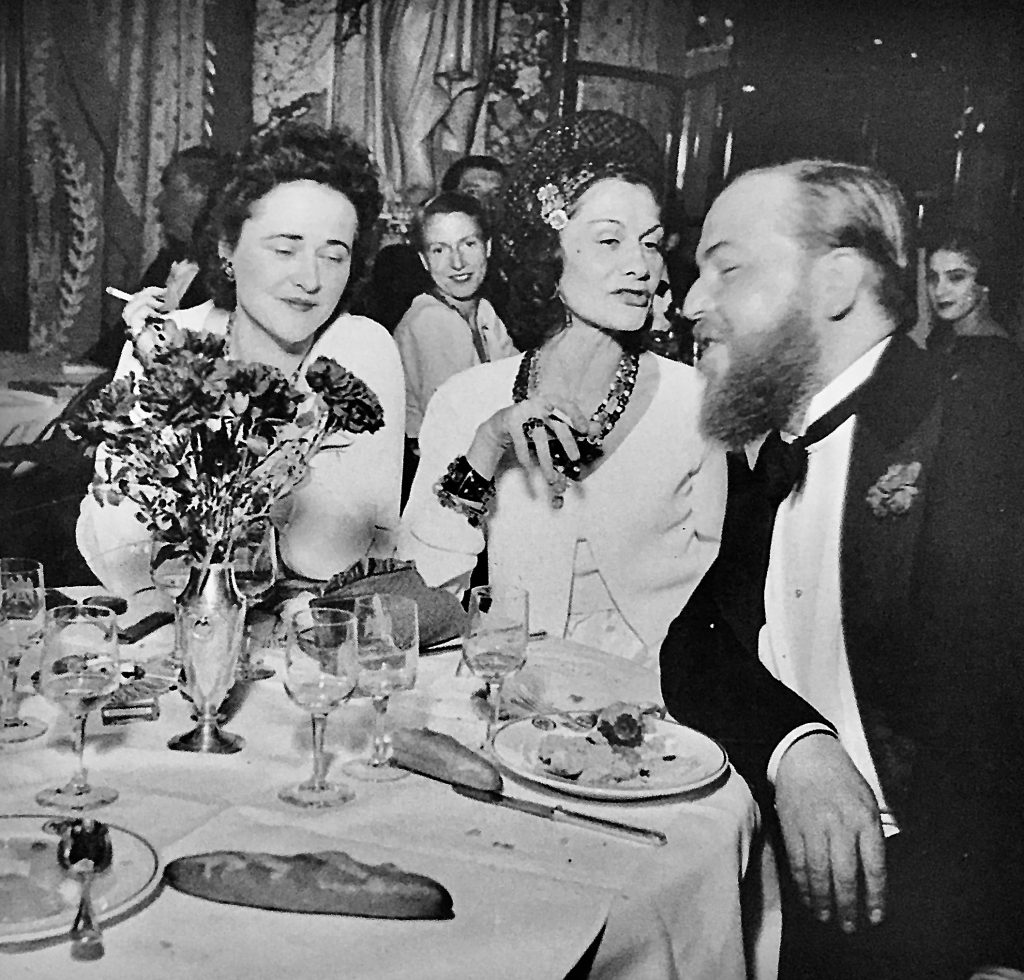
Chanel with Christian Bérard and the wife of Jean Hugo
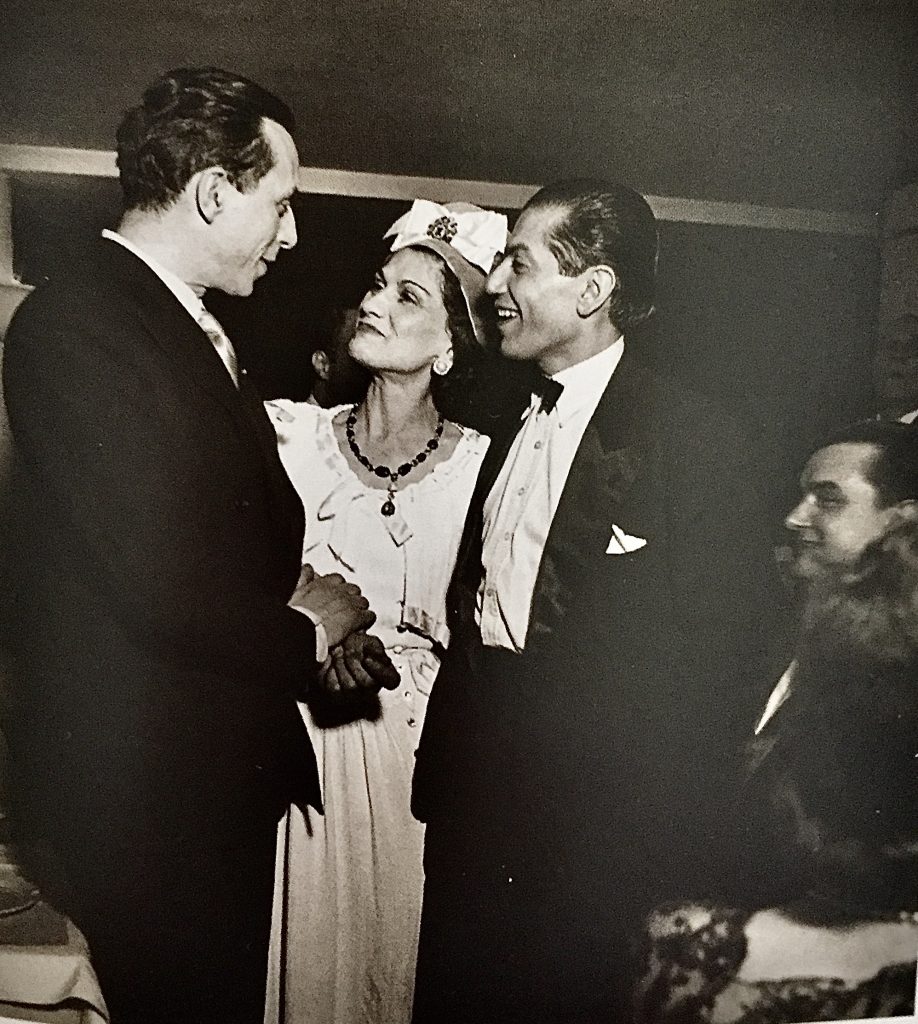
Chanel‘s dress in heavy white crepe with real and fake jewelry, pictured with Serge Lifar (right) and Jouvet (left). May 1938.
Her use of white accents in her fashion designs goes back to 1913 with the white petal collar on a long black velvet gown. Through the years, she wore crisp white blouses under jackets with cuffs turned back, a white bow might appear at the neck of a dress adding charm, white trim on a black suit, and the camélia for the perfect white touch. Picardie: “ she…used white in her designs to create the same sense of purity as was evident in the nuns’ wimples and collars at Aubazine.”

Chanel at supper after the opening of Les Ballet de Monte-Carlo. (l-r) Alexandra Danilova, Salvador Dali, Chanel and Georges Auric.
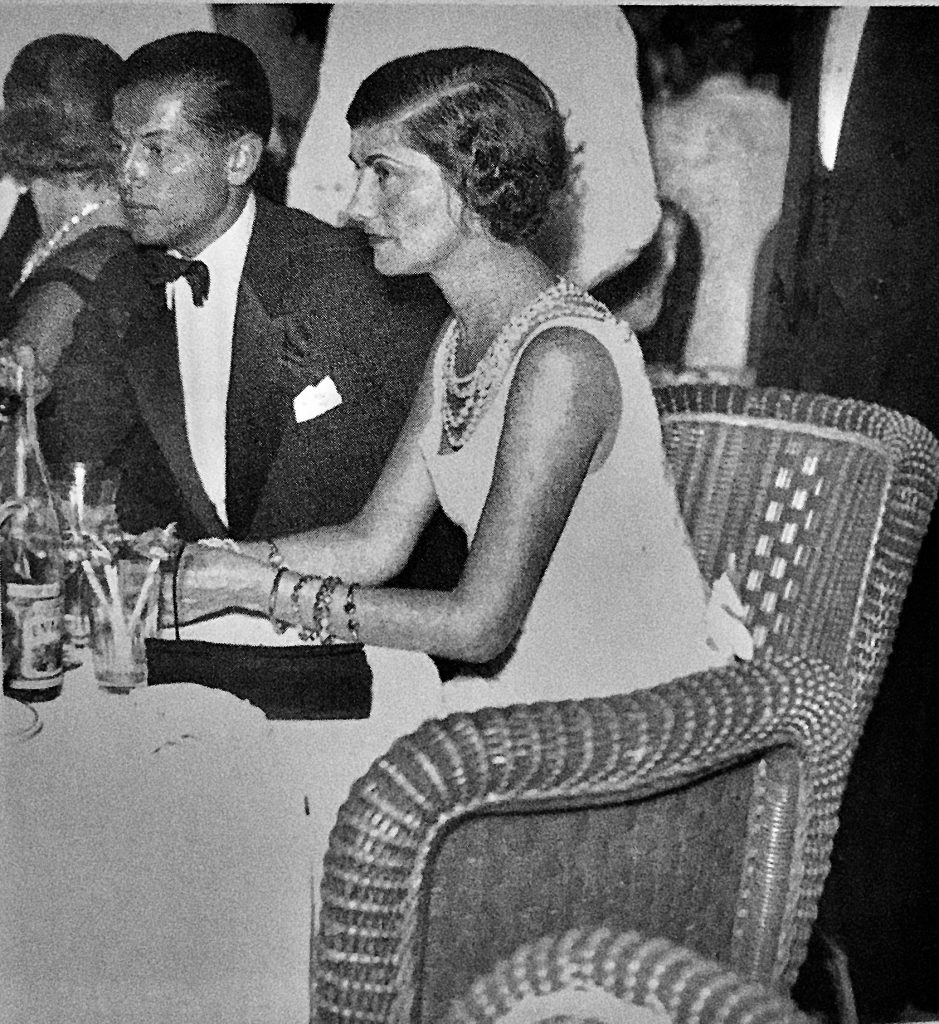
Chanel with ballet dancer, Serge Lifar, at a gala dinnr in Monte Carlo, 1933
The spiritual symbolism of white, harkening back to her days at Aubazine, became evident— described by Picardie: “which may be why she had used it to such a powerful effect in the winter funeral of a young friend, the poet Raymond Radiquet, who had died of typhoid fever in December 1923…as if honouring the medieval tradition of French queens and European royalty for whom the fitting color for deepest mourning was deemed to be white rather than black.”

Chanel with Christian Bérard (left)–he designed jewelry and illustrations for her and Jean-Michel Frank (right) interior designer. |
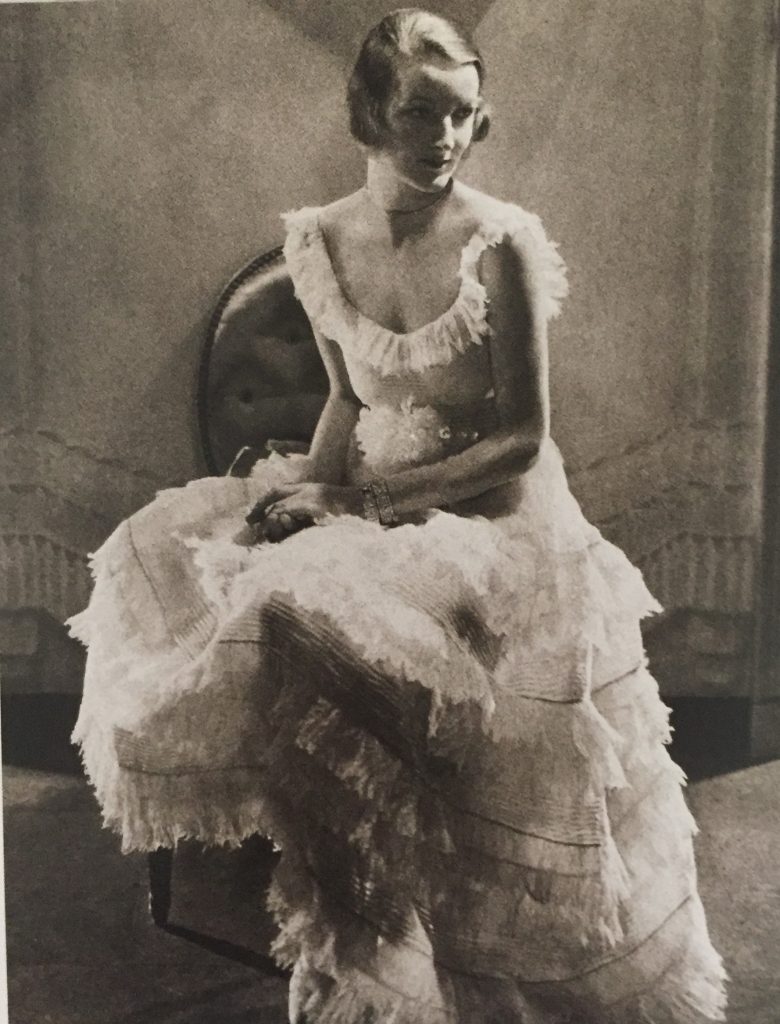
For this design, Chanel used white organdy. Steichen for Vogue 1930. |
Often, Gabrielle Chanel alluded to the impact her First Communion dress had—she was given the dress by her father. Picardie: “the hallowed dress of billowing organdy petticoats, and a long white veil. ‘It was the first dress, the most important dress, the dress that made her a couturière’, says Claude Delay, when I ask her what might have made it so meaningful; yet its symbolic purity as a dress for the Bride of Christ was also tainted by Chanel’s subsequent belief that it had been chosen by her father’s tart.”
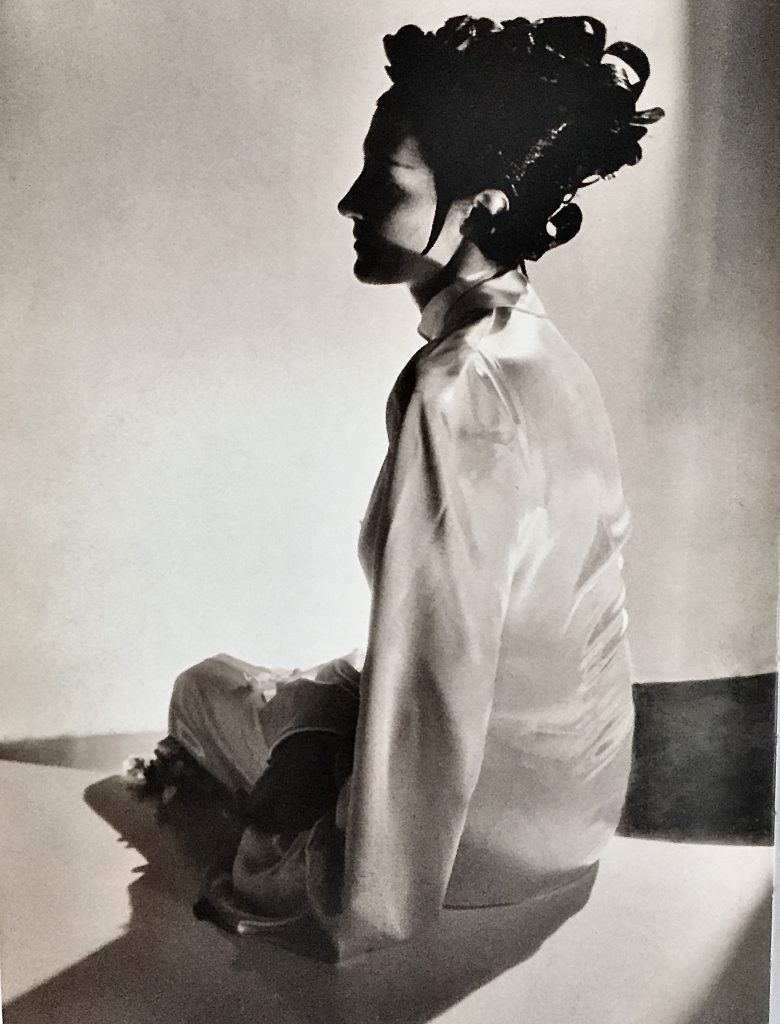
The Honourable Mrs. Reginald “Daisy” Fellowes’ white-satin “Mandarin” costume and coiffure were designed by Chanel. Her costume was worn at the “Oriental Ball”. White satin was the craze. Photo by Horst. It was but one among the flurry of balls. Chanel was a much sought-after guest.
Chanel was never a bride, but we will never know if that influenced her to seldom design wedding dresses. When she did include them in a collection, they were never presented at the end of a show as the finale. She viewed it as like a “circus” to do so.
Closest to Chanel at the end of her life were Claude Delay and Gabrielle Labrunie. They remarked how the color white can be traced back to her past: “recall(ing) that her sheets were always of plain white cotton, (‘as simple and unadorned as the white cuffs of her convent uniform, says Delay.)…Chanel reminisced about the white sheets and petticoats that were washed by the maids at the house of her aunts; everything boiled clean.”
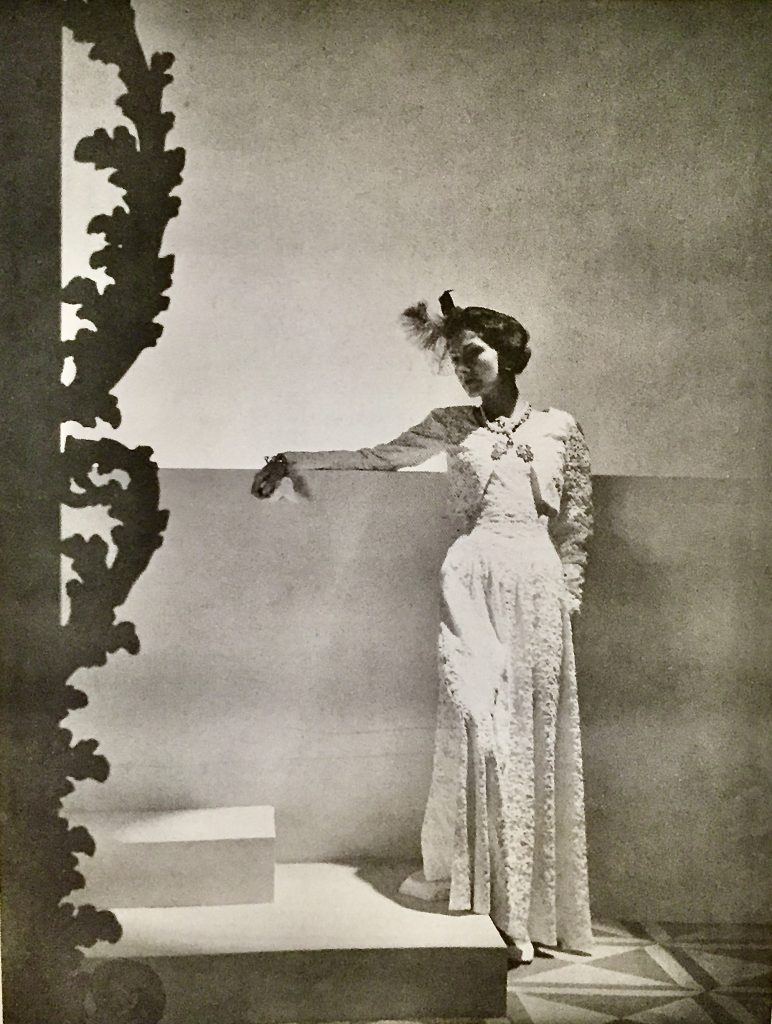
Chanel in a velvet-brocaded, white chiffon gown, and her fabulous emerald and ruby jewelry.
She had made the bolero jacket popular in the 1930s.
The contrast, and the impact, of white against bronzed skin was not lost on Chanel when recalling her jours d’été on the Riviera—it was she that had made tanning de rigueur. Once telling Paul Morand: “A very white earring on the lobe of a well-tanned ear delights me.”

A pretty young model dressed in white with a camellia in her hair standing on the mirrored staircase at the House of Chanel, rue Cambon. François Kollar. 1937
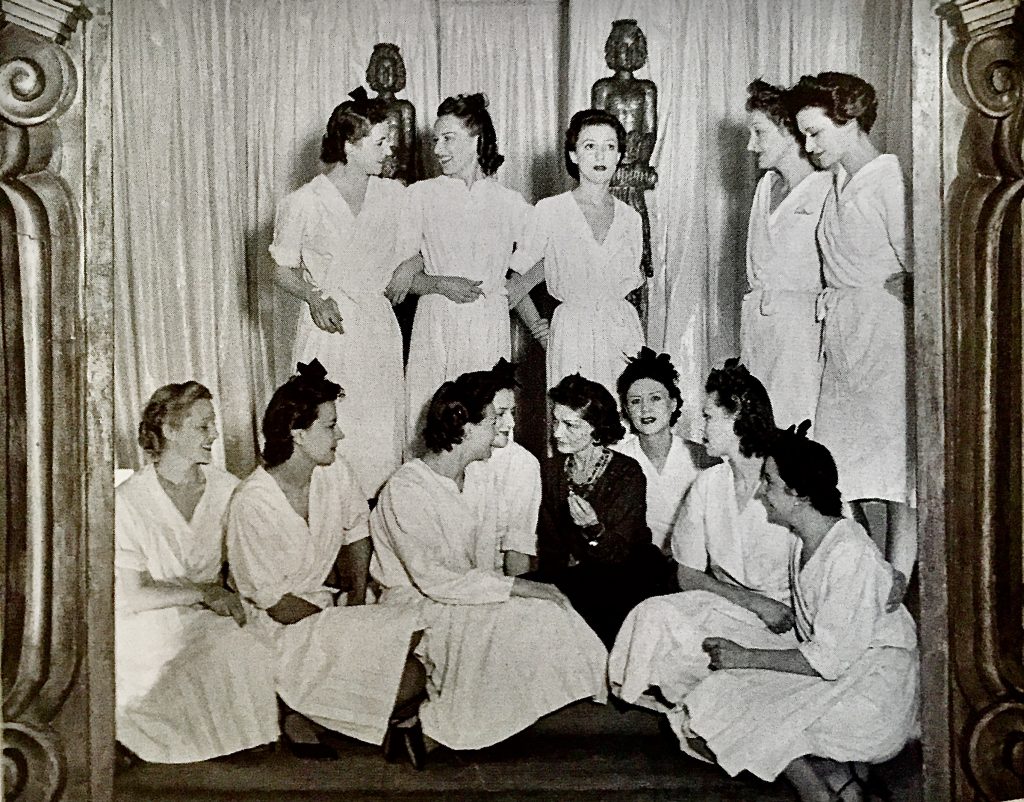
Chanel surrounded by her models dressed in white at the House of Chanel. Roger Schall
White says summer, enjoying carefree days wherever your favorite place happens to be, living life. Il est presque la, un été merveilleux! My favorite summer destination is the Côte d’Azur. Travel to the Côte, as we all know, has not been possible for what seems like forever, but who knows, maybe August 2021 will bring good news on that front.
À bientôt
Quotes and pictures:
Coco Chanel: The Legend and The Life, by Justine Picardie, published by it books, an imprint of Harper Collins Publishers.
Chanel and Her World: Friends, Fashion and Fame, by Edmonde Charles-Roux, published by The Vendome Press
Chanel: Her Style and Her Life, by Janet Wallach, published by Doubleday
The Little Book of Chanel, by Emma Baxter-Wright, published by Carlton Books
Chanel’s Riviera, by Anne de Courcy, published by St. Marten’s Press
Chanel: Collections and Creations, by Danièle Bott, published by Thames & Hudson
The Allure of Chanel, by Paul Morand, published by Pushkin Press 2017 Translated from the French by Euan Cameron
The Golden Riviera, by Roderick Cameron, published by Editions Limited


